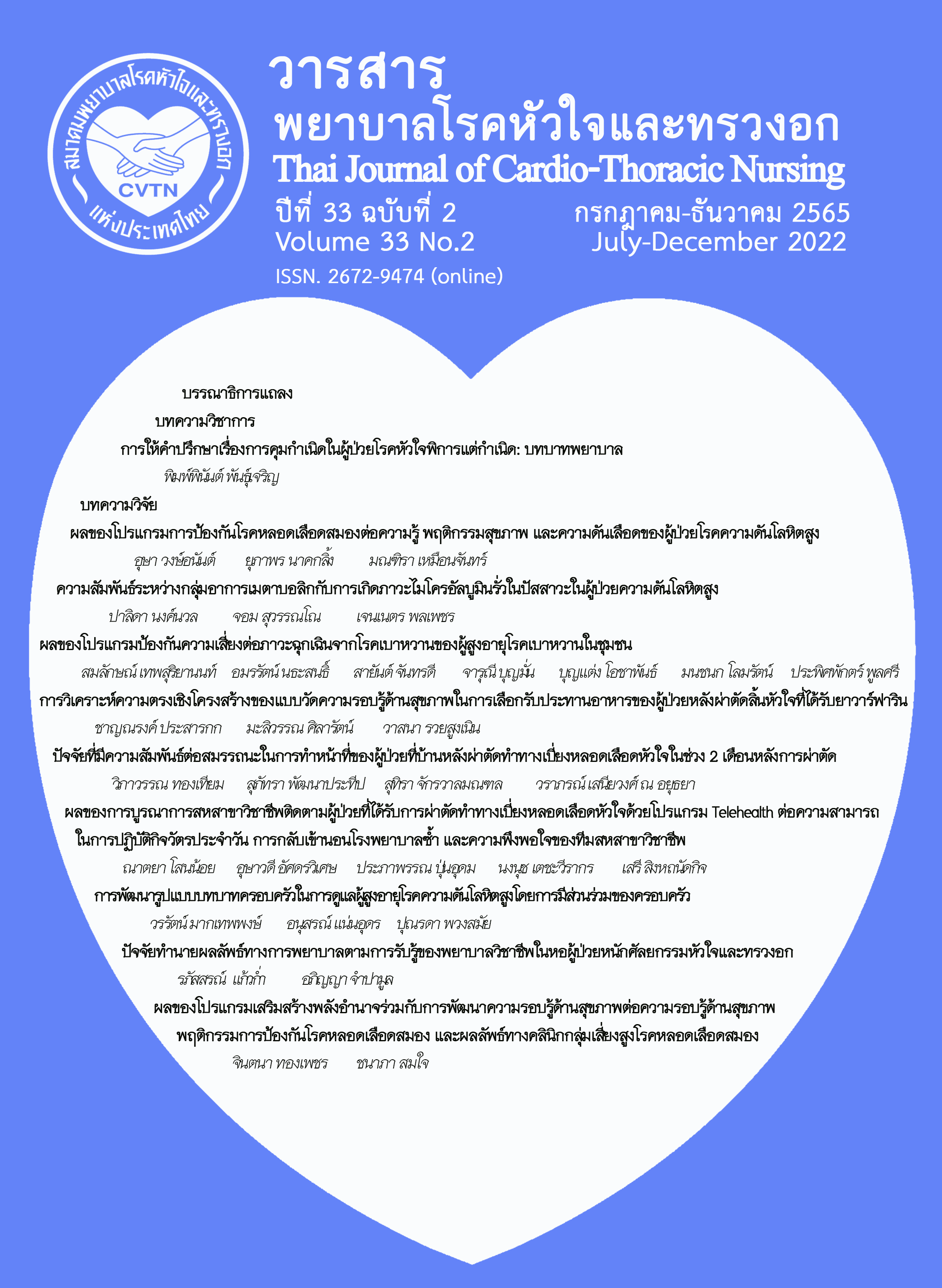Factorial structure analysis of food selection-related health literacy scale among patients receiving warfarin therapy post heart valve surgery
Keywords:
factorial structure analysis, health literacy, food selection, warfarinAbstract
The purpose of this study was to investigate the factorial structure of the food selection related health literacy scale developed by the researchers in a previous study. The 16-item scale was evaluated on 160 individuals who were prescribed warfarin after heart valve surgery. The Kaiser-Meyer-Olkin (KMO) test was used to determine sample adequacy, and Bartlett's test was employed to determine whether the data was suitable for factor analysis. Exploratory factor analysis (EFA) using Varimax rotation and confirmatory factor analysis (CFA) was used to analyze the factorial structure.
The KMO test result was 0.77, indicating the average sample adequacy. The Bartlett’s test of Sphericity gave a p-value of < 0.05, χ2 62.77, (df 127), demonstrating the data suitability for factor analysis. The EFA revealed that there were factors with eigenvalues greater than one that explained 59.93 percent of the variance. In the EFA, a new factor of the model has developed processing health literacy. However, the CFA produced a relative χ2 of 2.33, an SRMR of 0.08, an RMSEA of 0.09, a GFI of 0.84, and a CFI of 0.75. After model adjustment, the CFA recommended model 2, which consisted of 4 factors and 14 items and yielded a relative χ2 of 1.50, an SRMR of 0.06, an RMSEA of 0.06, a GFI of 0.92, and a CFI of 0.93. As a result, the model 2 produced a superior model fit.
This study indicated the need for further refinement of the factorial structure of the food selection-related health literacy scale to be utilized among patients taking warfarin following heart valve surgery.
References
Nishimura RA, Otto CM, Bonow RO, Carabello BA, Erwin JP 3rd, Fleisher LA, et al. 2017 AHA/ACC focused update of the 2014 AHA/ACC guideline for the management of patients with valvular heart disease: a report of the American College of Cardiology/American Heart Association Task Force on Clinical Practice Guidelines Circulation. 2017;135(25): e1159-e95.
Dangas GD, Weitz JI, Giustino G, Makkar R, Mehran R. Prosthetic heart valve thrombosis. J Am Coll Cardiol. 2016;68(24): 2670-89.
Wattanachai N, Kaewmoongkun S. Warfarin: Pharmacology and factors affecting its response. Srinagarind Med J. 2017;32(2):189-19. (in Thai).
Al-Momany NH, Makahleh ZM, Al-Omari NA, Al-Sarayreh HA, Momani RO. Analysis of factors that interrupt with INR control in the first anticoagulation clinic monitoring Jordanian patients. Clin Appl Thromb Hemost. 2019; 25:1-9.
Nasser S, Mullan J, Bajorek B. Challenges of older patients' knowledge about warfarin therapy. J Prim Care Community Health. 2012;3(1):65-74
Nutbeam D. Health literacy as a public goal: a challenge for contemporary health education and communication strategies into the 21st century. Health Promot Int 2000;15(3):259-67
Oramasionwu CU, Bailey SC, Duffey KE, Shilliday BB, Brown LC, Denslow SA, et al. The association of health literacy with time in therapeutic range for patients on warfarin therapy. J Health Commun. 2014;19(2):19-28.
Cabellos-García AC, Martínez-Sabater A, Castro-Sánchez E, Kangasniemi M, Juárez-Vela R, Gea-Caballero V. Relation between health literacy, self-care and adherence to treatment with oral anticoagulants in adults: a narrative systematic review. BMC Public Health. 2018;18(1): 1157.
Ferland G, Chahine S, Presse N, Dube MP, Nigam A, Blostein M, et al. Increasing dietary vitamin k intake stabilizes anticoagulation therapy in warfarin-treated patients with a history of instability: a 24-week randomized controlled trial (OR36-04-19). Curr Dev Nutr. 2019;3 (Supplement_1 June). nzz035.OR36–04–19, https://doi.org/10.1093/cdn/nzz035.OR36-04-19
Haun JN, Valerio MA, McCormack LA, Sørensen K, Paasche-Orlow MK. Health literacy measurement: an inventory and descriptive summary of 51 instruments. J Health Commun. 2014;19(Suppl 2): 302-33.
Magnani JW, Mujahid MS, Aronow HD, Cené CW, Dickson VV, Havranek E, et al. Health literacy and cardiovascular disease: fundamental relevance to primary and secondary prevention: a scientific statement from the American Heart Association.Circulation. 2018;138(2): e48-e74.
Yiu AW, Bajorek BV. Health literacy and knowledge in a cohort of Australian patients taking warfarin. Pharm Pract (Granada). 2018;16(1):1080.
Hair JF, Blak WC, Barbin BJ, Anderson RE. Multivariate data analysis. 8th edition. Andover Hampshire United Kingdom: Cengage; 2019.
Aree-Ue S, Youngcharoen P. The 6 Item cognitive function test- Thai version: psychometric property testing. Rama Nurs J. 2020;26(2):188-202. (in Thai).
Sakulsriprasert C. Confirmatory factor analysis. Thai Journal of Clinical Psychology; 44(1): 1-16. (in Thai).
Ousseine YM, Rouquette A, Bouhnik AD, Rigal L, Ringa V, Smith A', et al. Validation of the french version of the functional, communicative and critical health literacy scale (FCCHL). J Patient Rep Outcomes. 2017;2(3):1-6.
Khampang R, Kloyiam S, Butchon R. Factors associated with health literacy competencies: analysis of Thai health literacy survey 2019. Research Square [PREPRINT (Version 1)]. 2020 [cited 2022 Feb 25]. https://doi.org/10.21203/rs.3.rs-60016/v1
Stevens JP. Applied multivariate statistics for the social sciences.2nd edition. New Jersey: Erlbaum; 1992.
Dwinger S, Kriston L, Härter M, Dirmaier J, Translation and validation of a multidimensional instrument to assess health literacy. Health Expect. 2014;18(6): 2776–86.
Schmitt TA. Current methodological considerations in exploratory and confirmatory factor analysis. J Psychoeduc Assess. 2011;29(4): 304-21.
Ramlall I. Applied structural equation modelling for researchers and practitioners: Using R and stata for behavioral research. Bingley: Emerald; 2017.
Kline RB. Principles and practice of structural equation modeling. 4th Edition, New York: The Guilford Press; 2016.
DeVon HA, Block ME, Moyle-Wright P, Ernst DM, Hayden SJ, Lazzara DJ, et al. A psychometric toolbox for testing validity and reliability. J Nurs Scholarsh. 2007;39(2):155-64.
Ishikawa H, Yano E. Patient health literacy and participation in the health-care process. Health Expect. 2008;11(2):113-22.
Chinn D, McCarthy C. All Aspects of Health Literacy Scale (AAHLS: Developing a tool to measure functional, communicative and critical health literacy in primary healthcare settings. Patient Educ Couns. 2013;90(2):247-53.
Downloads
Published
How to Cite
Issue
Section
License
Copyright (c) 2023 Thai Journal of Cardio-Thoracic Nursing

This work is licensed under a Creative Commons Attribution-NonCommercial-NoDerivatives 4.0 International License.
บทความนี้ยังไม่เคยตีพิมพ์หรืออยู่ในระหว่างส่งไปตีพิมพ์ในวารสารอื่น ๆ มาก่อน และกองบรรณาธิการขอสงวนสิทธิ์ในการตรวจทาน และแก้ไขต้นฉบับตามเกณฑ์ของวารสาร ในกรณีที่เรื่องของท่านได้ได้รับการตีพิมพ์ในวารสารฉบับนี้ถือว่าเป็น ลิขสิทธิ์ของวารสารพยาบาลโรคหัวใจและทรวงอก






